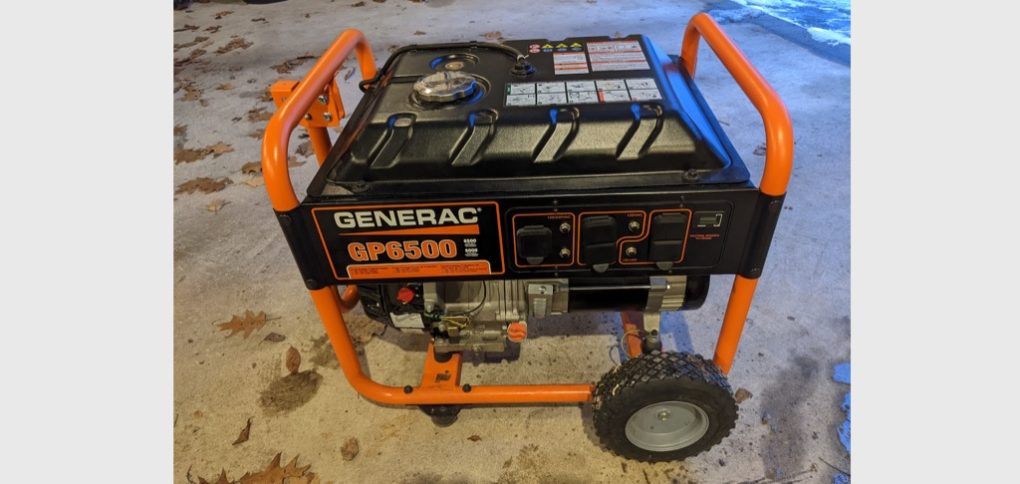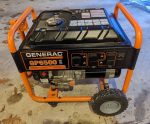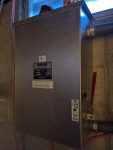
When high winds sweep through our area, it is not unusual for electrical service to be interrupted, sometimes for days at a time. For more than eight years now, a Generac GP 6500 gas-powered portable generator has provided my family with a reliable and effective way of dealing with the challenges of occasional, short-term power outages.
The Backstory
Nine years ago, my wife and I fled suburbia for a log home in the woods. There we provide most of our own utilities. We provide our own water with a well, our own sewage treatment with a septic tank, and our own heat with firewood. The one utility that we don’t usually provide for ourselves is electricity. For that we depend on the local power company.
One night about six months after we had moved into our home, a powerful wind storm roared through our area. Our power went down. A midnight call to the power company’s automated report line revealed that the outage was widespread, and that our electricity was not expected to be restored for more than a week.
Early the next morning, my wife and I arrived at a local hardware store soon after it opened. There we purchased a Generac GP 6500 gas-powered portable generator. This was a situation where the adage “panic early” paid off. Long before noon, all of the generators in the store were sold out.
Choosing the Right Size
When buying a generator, the first key question is, “How large a generator should I buy?” If the generator is too small, it will not support the desired load. If the generator is too large, it will consume an excessive amount of fuel.
A person could calculate the absolute maximum wattage that the breaker box in their home can handle by multiplying the amperage of the main breaker by the voltage of the main breaker. Or they could multiply the amperage of the breaker for each circuit in the box by the voltage of each of those breakers, and then add the wattage for each of the breakers together. Each of these solutions would result in a number that is much too high. If a person is not constantly tripping every one of the circuit breakers in their box, then they are not running all of their various circuits continuously at maximum capacity.
A better way to calculate optimum generator size is for the person to work their way from room to room in their home, and make note of absolutely every electrical item that they would want to be able to run simultaneously while operating on generator power. For example, the person might note that in the kitchen they want to run the refrigerator, the electric stove, the microwave, and the light fixtures simultaneously. In the basement they might note that they want to run the freezer, the well pump, the furnace fan, and the ceiling lights simultaneously. Lists of the typical wattage requirements for each of these types of devices are available on the internet at sites like this one. They could also find wattage requirements by checking the documentation of each individual item. The person could then total up all of the devices that they wish to run simultaneously, multiply by two to allow for start-up wattage, and purchase an appropriately sized generator.
I chose a third option: I rushed to the hardware store in a state of desperation, and made a wild guess. I chose the second largest generator in the store. This is not the best strategy for finding the optimum sized generator, but I got lucky. The generator we selected ended up being the perfect size for our use.
 The Generac GP 6500 provides 6,500 watts of running power and 8,000 watts of peak motor/compressor starting power. According to statistics provided by our power company, the usage of our home is unusually low when compared with other households in our area. This may suggest that other households in our area would need a larger generator than the one we selected.
The Generac GP 6500 provides 6,500 watts of running power and 8,000 watts of peak motor/compressor starting power. According to statistics provided by our power company, the usage of our home is unusually low when compared with other households in our area. This may suggest that other households in our area would need a larger generator than the one we selected.
Safe Wiring Is A Must
 I wanted to be able to use the generator without running an extension cord through a window to a power strip and then multiple cords from the power strip throughout the house to each individual device that I wanted to run. I also did not want to use an illegal and highly dangerous “suicide cord” with plugs on both ends to run from the generator to the house system. Instead, I hired a professional electrician from our church to install a power inlet box on the outside of the house to connect with a cord from the 220-volt outlet on the generator.
I wanted to be able to use the generator without running an extension cord through a window to a power strip and then multiple cords from the power strip throughout the house to each individual device that I wanted to run. I also did not want to use an illegal and highly dangerous “suicide cord” with plugs on both ends to run from the generator to the house system. Instead, I hired a professional electrician from our church to install a power inlet box on the outside of the house to connect with a cord from the 220-volt outlet on the generator.
 He then connected the inlet box to the main panel through a transfer switch that would not allow the generator and the main power line to be connected to the circuit box at the same time. This would prevent the generator from backfeeding current into the main power line, and possibly electrocuting a lineman from the power company who was working to restore the outage.
He then connected the inlet box to the main panel through a transfer switch that would not allow the generator and the main power line to be connected to the circuit box at the same time. This would prevent the generator from backfeeding current into the main power line, and possibly electrocuting a lineman from the power company who was working to restore the outage.
Bringing the Generator Online
When I want to bring the generator online, I first connect the power cord from the 220-volt outlet on the generator to the power inlet box on the side of the house. Next, I go down to the circuit box in the basement, and turn off each of the breakers. This is to prevent the generator from being overloaded by the simultaneous startup of every appliance in the house.
When all of the breakers in the circuit box are off, I start the generator. I use the transfer switch to bring the circuit box online with the generator rather than with the grid. Next, I turn on each of the breakers for the circuits that I wish to use, one at a time. This increases the load on the generator gradually, rather than all at once.
When electrical service from the power company is restored, it is a simple matter to switch back to the grid. I simply shut down and unplug the generator and turn the transfer switch back to the grid.
Fuel Choices
At the time when we purchased our generator, only gasoline-powered generators were in stock. Since that time, dual fuel and even tri-fuel generators have become more widely available. For someone who lives in an area with access to natural gas utilities, natural gas could be a very convenient source of fuel. For others, propane can be much more convenient than gasoline. For those with access to all three, options can be a wonderful thing.
Patterns of Usage
We do not run the generator continuously when the power is out. We only run it for an hour or two each morning and an hour or two each evening. This keeps the food in the refrigerator cool, the food in the freezer frozen, provides us with hot and cold running water to get ready in the morning, allows us to flush the toilet a couple of times a day, and allows us to cook a hot meal for supper without breaking out the camping equipment. The rest of the time we are able to get along well with a wood stove, candles, and battery-powered devices.
Fuel Consumption
During a recent power outage, we ran the generator for a total of about eight hours over the course of three days. During that time, the generator consumed about five gallons of gasoline. The fuel tank on the generator holds about 6.5 gallons.
Noise Level
Like most portable generators, the Generac GP 6500 is unpleasantly noisy. One of the reasons we only run the generator for an hour or two each morning and an hour or two each evening is to conserve fuel. The other reason is that we just get sick of the racket. We moved to a log home in the woods because we like peace and quiet. There is no peace and quiet as long as the generator is running.
Generator Placement
The very first time we used the generator, we placed it on our front porch. That was a mistake. The sound and vibration produced by the generator carried through the planks of the porch and into the frame of the house.
We have found that if we place the generator instead on the concrete-paver-and-gravel sidewalk next to the house, less sound and vibration carry into the house.
Returning to Storage
When the power outage is over, there are a number of steps I take to prepare the generator to return to storage.
First, I siphon as much gasoline as possible out of the tank. I then restart the generator, and run it until the tank and fuel line go dry. This prevents gasoline from seeping into the carburetor, evaporating there, and leaving the carburetor dirty. It also prevents the gasoline in the tank from going bad, and making the generator harder to start, the next time I need it. Every time I have run the tank dry, the generator has started on the first pull of the starter cord the next time I needed it. The one time I left residual fuel in the tank, I had a difficult time starting the generator the next time I needed it.
After the fuel tank is dry, I drain the oil from the engine, and then refill it with fresh oil. Used oil contains acids that may corrode the internal parts of the engine. I refill the oil pan with fresh oil so that it is ready for immediate use the next time that I need it.
Finally, I cover the generator to protect it from dust, and place it under a wide shelf in my barn. There it sits, out of sight and out of mind until the next time the power goes down.
Conclusions
The Generac GP 6500 portable generator provides reliable and effective electrical service to our home during occasional, short-term power outages of up to several days in length. It is not designed for permanent or long-term use. Within these design limits, it is an excellent solution for powering a home with moderate electrical demand during a short-term, grid-down situation.
Disclaimer
I did not receive any financial or other inducements to mention any vendor, product, or service in this article.

